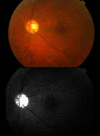Tubercular serpiginous-like choroiditis
- PMID: 22675097
- PMCID: PMC3207773
- DOI: 10.1136/bcr.08.2011.4654
Tubercular serpiginous-like choroiditis
Abstract
Choroidal tuberculosis (TB) infection may present itself as a diffuse choroiditis that resembles serpiginous choroiditis, usually treated with immunossupressants. Recent studies have demonstrated that patients with serpiginous-like choroiditis and evidence of systemic or latent TB are best treated with antituberculosis treatment (ATT) in addition to the corticosteroid therapy. The authors present a case of a 58-year-old man with decreased vision in his left eye. His best-corrected visual acuity was 20/20 right eye and 20/200 left eye. Funduscopic examination revealed a diffuse choroiditis. Mantoux skin test showed an area of induration measuring 30×35 mm and the patient started ATT with complete resolution of retinal lesions after 2 weeks of treatment. His final visual acuity was 20/25 in the left eye with no recurrences over a follow-up of 6 months. The use of ATT in these patients is likely to reduce active inflammation and eliminate future recurrences.
Conflict of interest statement
Figures



Similar articles
-
Tubercular serpiginous-like choroiditis presenting as multifocal serpiginoid choroiditis.Ophthalmology. 2012 Nov;119(11):2334-42. doi: 10.1016/j.ophtha.2012.05.034. Epub 2012 Aug 11. Ophthalmology. 2012. PMID: 22892153
-
Presumed tubercular serpiginouslike choroiditis: clinical presentations and management.Ophthalmology. 2003 Sep;110(9):1744-9. doi: 10.1016/S0161-6420(03)00619-5. Ophthalmology. 2003. PMID: 13129872
-
TREATMENT OF REFRACTORY TUBERCULAR SERPIGINOUS-LIKE CHOROIDITIS WITH INTRAVITREAL METHOTREXATE.Retin Cases Brief Rep. 2021 Mar 1;15(2):169-173. doi: 10.1097/ICB.0000000000000767. Retin Cases Brief Rep. 2021. PMID: 29979252
-
Collaborative Ocular Tuberculosis Study Consensus Guidelines on the Management of Tubercular Uveitis-Report 1: Guidelines for Initiating Antitubercular Therapy in Tubercular Choroiditis.Ophthalmology. 2021 Feb;128(2):266-276. doi: 10.1016/j.ophtha.2020.01.008. Epub 2020 Jan 11. Ophthalmology. 2021. PMID: 32115264
-
Tubercular posterior scleritis: A case report and review of literature.Indian J Ophthalmol. 2019 Aug;67(8):1362-1365. doi: 10.4103/ijo.IJO_1942_18. Indian J Ophthalmol. 2019. PMID: 31332144 Free PMC article. Review.
Cited by
-
Infectious uveitis: an Asian perspective.Eye (Lond). 2019 Jan;33(1):50-65. doi: 10.1038/s41433-018-0224-y. Epub 2018 Oct 12. Eye (Lond). 2019. PMID: 30315262 Free PMC article. Review.
-
[Serpiginous-Like Choroiditis: literature Review].Rev Fac Cien Med Univ Nac Cordoba. 2022 Mar 9;79(1):48-52. doi: 10.31053/1853.0605.v79.n1.32223. Rev Fac Cien Med Univ Nac Cordoba. 2022. PMID: 35312256 Free PMC article. Review. Spanish.
-
Successful treatment of tubercular multifocal serpiginous-like choroiditis without use of anti-inflammatory drugs: A case report with multimodal imaging.J Curr Ophthalmol. 2018 Sep 1;31(2):229-233. doi: 10.1016/j.joco.2018.08.003. eCollection 2019 Jun. J Curr Ophthalmol. 2018. PMID: 31317106 Free PMC article.
References
-
- Alvarez S, McCabe WR. Extrapulmonary tuberculosis revisited: a review of experience at Boston City and other hospitals. Medicine (Baltimore) 1984;63:25–55 - PubMed
-
- Kotake S, Kimura K, Yoshikawa K, et al. Polymerase chain reaction for the detection of Mycobacterium tuberculosis in ocular tuberculosis. Am J Ophthalmol 1994;117:805–6 - PubMed
-
- Gupta V, Arora S, Gupta A, et al. Management of presumed intraocular tuberculosis: possible role of the polymerase chain reaction. Acta Ophthalmol Scand 1998;76:679–82 - PubMed
-
- Bowyer JD, Gormley PD, Seth R, et al. Choroidal tuberculosis diagnosed by polymerase chain reaction. A clinicopathologic case report. Ophthalmology 1999;106:290–4 - PubMed
-
- Barondes MJ, Sponsel WE, Stevens TS, et al. Tuberculous choroiditis diagnosed by chorioretinal endobiopsy. Am J Ophthalmol 1991;112:460–1 - PubMed
Publication types
MeSH terms
Substances
LinkOut - more resources
Full Text Sources
